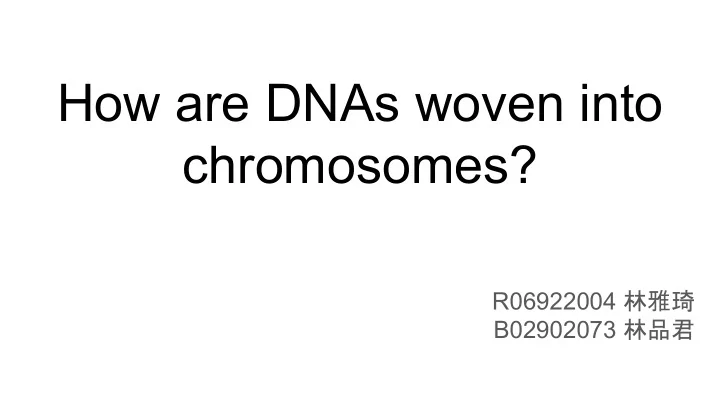

How are DNAs woven into chromosomes? R06922004 林雅琦 B02902073 林品君
Some important proper nouns Chromatid Chromatin
Questions 1. How are chromosomes packaged into threads as opposed to balls? 2. How is DNA belonging to the same molecule invariably packaged into the same chromatid? 3. What is responsible for the rigidity and elasticity of the longitudinal axes of chromosomes that prevent them from being unraveled when pulled on by the mitotic spindle in the process of sister chromatid separation?
They all depend on... “Structural Maintanence of Chromosomes kleisin complex” ● a class of enzymes ● entrap DNA inside a “ring”
How does SMC-kleisin work? ● “HEAT”(Hungtingtin/EF3/PP2A/tor1) ○ hook-shaped protein ○ bind kleisin → regulate the activity of ATPase and DNA
What can SMC-kleisin do? ● “cohesin” ○ holding sister chromatids together
What can SMC-kleisin do? ● “condensin” ○ Organizing DNA into chromatid How does it function?
Condensin Some guess… ● Condensin Crosslinks DNA ○ entraps two segments from the same DNA ○ “Hawk” subunits interact with each other
Condensin Another guess… ● Condensin supercoiling DNAs
Problem DNAs diffuse in 3 dimensional space, why don’t they just tangled together?
“The process of experimental science does not consist in explaining the unknown by the known, as in certain mathematical proofs, it aims to give an account of what is observed by the properties of what is imagined.” So scientists try to find a theory to explain the important phenomena.
loop-extrusion (LE) theory ● condensin possesses the ability to trap small bights of DNA and then extrude these in a processive manner into longer and longer loops ● explains why chromatids are cylindrical and what constitutes their longitudinal axis ● ensure that looped DNA is not recatenated ● https://youtu.be/Tn5qgEqWgW8
Loop-extrusion (LE) theory
Two condensin in cells -- difference when building loops ● condensin I: shorter ● condensin II: earlier, eventually building loops up to 400 kilobases (kb) in length
But there is still some issues… ● There has been no evidence that condensin can actually extrude loops of DNA → it was observed to translocate and not to extrude DNA into loops ● Is the complexes observed in the act of translocation contained single or multiple condensin rings? ● This is a highly important issue, as one way of imagining how translocation could be turned into LE is if two different complexes were to translocate in opposite directions while somehow joined together.
Possible answer ● Terakawa’s finding: condensin translocates in a highly processive manner along DNAs stretched out on a glass slide in vitro. ● The discovery that condensin is a DNA translocase is certainly consistent with the idea that it functions as a loop extruder. ● The design of the experiments make the DNAs be stretched out on slides with each end tethered. Thus, even if an individual complex tried to extrude DNAs, the tension in the DNA would not have permitted it to do so, and translocation instead of LE ensued.
For future ● “We certainly observe these visible pieces as closely as we can, but at the same time we seek to divine the hidden gears and parts that explain its apparent motions. Our task is to explain the complications of the visible in terms of invisible simplicity.” ● The invisible simplicity responsible for creating complex chromosomes out of immense tangled skeins of DNA are SMC-kleisin complexes. The findings of Terakawa et al. are just the beginning of the story. Seeing this happen inside cells, as well as in a test tube, represents another huge challenge.
Recommend
More recommend